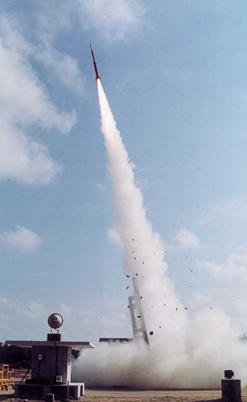 Launch of RH-300 Mk2 from TERLS | |
 | |
| Location | Thumba, Thiruvananthapuram, Kerala, India |
|---|---|
| Coordinates | 8°32′34″N76°51′32″E / 8.54278°N 76.85889°E |
| Time zone | UTC+05:30 (IST) |
| Short name | TERLS |
| Established | 21 November 1963 |
| Operator | ISRO |
Thumba Equatorial Rocket Launching Station (TERLS) is India's first rocket launching station and was established on 21 November 1963. [1] [2] Operated by ISRO, it is located in Thumba, Thiruvananthapuram, which is near the southwestern tip of mainland India, very close to Earth's magnetic equator. It is currently used by ISRO for launching sounding rockets. [1]
Contents
The first rockets were assembled in the former St Louis High School, which now houses a space museum. [3] The local Bishop of Trivandrum, Rev. Peter Bernard Periera, along with Vincent Victor Dereere (a Belgian) and district collector Madhavan Nair were instrumental in acquiring a large parcel of land measuring 600 acres from coastal community. [4] Periera had given away the prayer hall and bishop's room in the local church. Minister of State for External Affairs, Lakshmi N. Menon helped to smooth bureaucratic hurdles facing the project in Delhi. [5] H. G. S. Murthy was appointed as the first Director of Thumba Equatorial Rocket Launching Station. [6]
Rockets launched from the site include RH-300, M-100, Nike Apache, Arcas, Boosted Arcas, Skua 1, Centaure, Centaure 2A, Centaure 2B, Nike Tomahawk, Dragon 1, Judi-Dart, Boosted Arcas 2, Petrel 1, RH-75, Skua 2, Sandhawk Tomahawk, Menaka II, RH-125, M-100B, M-100A, RH-200 and RH-300 Mk II. [2]
The site has five launchpads:
- Pad 1 at 8°32′00″N76°52′02″E / 8.533440511878172°N 76.86728897138364°E , sounding rockets [7]
- Pad 2 at 8°31′58″N76°52′05″E / 8.53268929608746°N 76.86794175657239°E , sounding rockets [8]
- Pad 3 at 8°31′49″N76°52′11″E / 8.530164446832044°N 76.86979707233245°E , sounding rockets [9]
- Pad 4 at 8°31′46″N76°52′15″E / 8.529557306065989°N 76.87081759512913°E , sounding rockets [10]
- Pad 5 at 8°31′53″N76°52′08″E / 8.531419615302084°N 76.86902030573928°E , RH-300 launch complex, active after 1993 [11]
